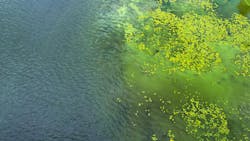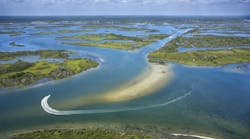EPA announces $3.7 million in grants to reduce HABs in Lake Erie
The U.S. Environmental Protection Agency (EPA) announced on June 25, 2025, four Michigan and Ohio grant recipients will receive $3,712,124 to engage farmers and provide nutrient management technical assistance in the Western Lake Erie Basin. Nutrient runoff from agricultural land is the leading cause of harmful algal blooms in Lake Erie.
"Keeping fertilizer on the fields is a win for farmers and a win for water quality," said EPA Region 5 Administrator and Great Lakes National Program Manager Anne Vogel. "This funding helps farmers apply nutrients more efficiently, safeguarding the long-term health and sustainability of Lake Erie."
The selected organizations include:
- Ohio Department of Agriculture has been selected for a $1 million grant to employ four conservation agronomist positions within Ohio’s Maumee River watershed. Each position will be paired with a private sector agricultural retailer to help integrate conservation services into their business model. The agronomists will provide technical assistance on 300,000 acres of cropland in the watershed as part of the state’s H2Ohio program with the goal of reducing an estimated 10,000 pounds of total phosphorus entering the waterway.
- The Nature Conservancy has been selected for a $783,616 grant to utilize a farmer-led network of conservation advocates to directly engage 200 other farmers in peer-to-peer learning opportunities across Indiana, Michigan, and Ohio. TNC will deliver technical training to 60 conservation professionals and will partner with The Ohio State University to create new training and engagement materials.
“We want to thank the Environmental Protection Agency for this grant and look forward to working with farmers across the Western Lake Erie Basin to educate and support them in expanding edge of field practices, which are proven to improve water quality and reduce nutrient runoff,” said The Nature Conservancy Ohio Agriculture Director Jessica D’Ambrosio. “By implementing edge of field practices, like adding vegetated buffers or two-stage ditches, farmers can help make the Western Lake Erie Basin more resilient while further protecting their fields from short-term threats, including flooding and drought.” - Lenawee County Soil and Water Conservation District has been selected for a $937,691 grant to boost its capacity to engage with and provide technical assistance to Michigan farmers and agricultural retailers. Funds will support two staff positions for four years. SWCD will promote effective fertilizer use and develop an easy-to-use phosphorus management plan template that retailers can use with their clients.
"The Lenawee Conservation District is thankful for this opportunity to increase our capacity to provide technical assistance and educational opportunities to residents of Lenawee County and the larger Western Lake Erie Basin," said Lenawee Conservation District Manager Brooke Bollwahn. - Regents of the University of Michigan has been selected for a $990,817 grant to provide technical resources, professional development, and web-based tools to track nutrient management plans through five conservation districts, with the goal to increase the number of acres with nutrient management plans in Michigan's portion of the basin by 2028.
"As we tackle the pressing issue of harmful algal blooms in the Western Lake Erie Basin, the University of Michigan Water Center is committed to forging strong partnerships and leveraging innovative strategies to enhance water quality,” said U-M Water Center Collaborative Research Specialist Dr. Alison Bressler. “Our project aims to foster collaboration between local Conservation Districts, private technical service providers, and agricultural producers in order to significantly reduce nutrient runoff, ensuring sustainable agricultural practices and a healthier Lake Erie for generations to come."
Funding is provided by the Great Lakes Restoration Initiative (GLRI). Under the GLRI, federal agencies work with nonfederal partners to strategically target the biggest threats to the Great Lakes ecosystem and to accelerate efforts to protect and restore the largest system of fresh surface water in the world.
Federal grant recipients must satisfy legal and administrative requirements to receive funds from EPA.


